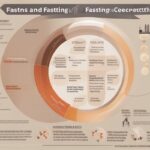Welcome to your go-to resource for understanding how fasting can transform your approach to weight management! If you’ve ever wondered whether skipping meals could be the key to shedding those extra pounds, you’re in the right place. In this comprehensive fasting guide, I’ll walk you through the ins and outs of fasting, how it impacts your body, and why it’s become a popular strategy for sustainable weight loss. Whether you’re a newbie or a seasoned faster, my goal is to equip you with practical tips and science-backed insights to make fasting work for you. Let’s dive into this journey of health and wellness together, exploring how intermittent fasting and other methods can be powerful tools for managing your weight.
What Is Fasting, and How Does It Relate to Weight Management?
Fasting, at its core, is the voluntary abstinence from food and sometimes drink for a specific period. It’s not a new concept—humans have practiced fasting for centuries, often for religious or cultural reasons. Today, however, it’s gained massive attention as a weight management strategy. The idea is simple: by reducing the window of time you eat, you naturally cut down on calorie intake, which can lead to weight loss. But there’s more to it than just eating less. Fasting triggers unique physiological changes in your body, like improved insulin sensitivity and fat-burning processes, that can enhance weight management efforts (Mattson et al., 2017). In this fasting guide, we’ll unpack these mechanisms and show you how to apply them effectively.
The Science Behind Fasting and Weight Loss
Let’s get into the nitty-gritty of why fasting works for weight management. When you fast, your body shifts from using glucose (sugar from food) as its primary energy source to burning stored fat. This process, known as ketosis, kicks in after about 12–16 hours of fasting, depending on your activity level and metabolism (Anton et al., 2018). Additionally, fasting lowers insulin levels, which allows your body to access fat stores more easily. Studies have shown that intermittent fasting, a popular method, can lead to a 3–8% reduction in body weight over 3–24 weeks (Varady et al., 2013). Beyond calorie restriction, fasting also influences hunger hormones like ghrelin and leptin, helping to curb appetite over time (Sumithran et al., 2011). This dual action—burning fat and reducing hunger—makes fasting a potent tool in any weight loss plan.
Different Types of Fasting for Weight Management
Not all fasting methods are created equal, and finding the right one for you is key to success. Here are some popular approaches outlined in this fasting guide that have been shown to support weight management:
- Intermittent fasting (IF): This involves cycling between eating and fasting periods. The 16/8 method (fast for 16 hours, eat during an 8-hour window) is a favorite for beginners.
- 5:2 diet: Eat normally for five days of the week, then restrict calories to 500–600 on two non-consecutive days. It’s less about timing and more about calorie control.
- Alternate-Day Fasting (ADF): Alternate between normal eating days and fasting days (or very low-calorie days). Research shows ADF can be effective for weight loss (Trepanowski et al., 2017).
- Time-Restricted Eating (TRE): Limit your eating to a specific window each day, like 12 pm to 8 pm, to align with your body’s natural circadian rhythm.
Each method has its perks, and what works for one person might not work for another. Experiment with these fasting strategies to see which fits your lifestyle best.
Practical Tips to Start Your Fasting Journey
Ready to give fasting a try? Before you jump in, let’s go over some actionable steps to ensure you’re set up for success. Fasting for weight management isn’t just about skipping meals—it’s about doing it safely and sustainably. As your fasting guide, I’ve compiled a list of tips to help you ease into this practice without feeling overwhelmed or deprived.
- Start Small: If you’re new to fasting, don’t dive into a 24-hour fast right away. Begin with a 12-hour overnight fast (e.g., stop eating at 8 pm and eat again at 8 am) and gradually increase the duration.
- Stay Hydrated: Drink plenty of water during fasting periods to avoid dehydration, which can mimic hunger and lead to overeating later.
- Focus on Nutrient-Dense Foods: When you do eat, prioritize whole foods—think lean proteins, healthy fats, and veggies—to keep your body fueled and satisfied.
- Listen to Your Body: If you feel dizzy, fatigued, or unwell, break your fast. fasting should feel challenging but not unbearable.
- Track Your Progress: Use a journal or app to log your fasting hours, meals, and how you feel. This helps identify patterns and adjust as needed.
Remember, fasting is a personal journey. Take it slow, and don’t hesitate to consult a healthcare professional if you have underlying health conditions or concerns.
Potential Challenges and How to Overcome Them
Like any lifestyle change, fasting comes with its share of hurdles. Hunger pangs, irritability (hello, “hanger”), and social pressures can make sticking to a fasting plan tricky. But don’t worry—this fasting guide has got you covered. One common issue is dealing with cravings during fasting windows. Research suggests that these cravings often subside after the first few weeks as your body adjusts (Harvey et al., 2018). In the meantime, sipping on black coffee, tea, or water can help distract you. Another challenge is navigating social events—try scheduling your eating windows around gatherings or communicate your goals with friends for support. Lastly, avoid overeating during non-fasting periods, as this can negate the calorie deficit fasting creates. Planning balanced meals ahead of time can keep you on track.
Who Should Avoid Fasting, and When to Seek Advice
While fasting can be a fantastic tool for weight management, it’s not for everyone. Certain groups should approach fasting with caution or avoid it altogether. Pregnant or breastfeeding women, individuals with eating disorders, and those with medical conditions like diabetes or low blood pressure should consult a doctor before starting any fasting regimen (Mattson et al., 2017). Even if you’re generally healthy, it’s wise to check in with a healthcare provider if you’re on medication or unsure how fasting might affect you. This fasting guide emphasizes safety first—weight loss should never come at the cost of your well-being. If you experience persistent side effects like extreme fatigue or headaches, it’s a sign to pause and reassess your approach with professional guidance.
In wrapping up, fasting offers a promising path to weight management when done thoughtfully. It’s not a one-size-fits-all solution, but with the right approach, it can help you achieve your health goals while fostering a better relationship with food. This fasting guide has covered the science, the methods, and the practical know-how to get started, but the real magic happens when you tailor fasting to your unique needs. Be patient with yourself, celebrate small wins, and remember that sustainable weight loss is a marathon, not a sprint. Have questions or personal experiences with fasting? Drop a comment below—I’d love to hear how this journey is unfolding for you!
References
- Anton, S. D., Moehl, K., Donahoo, W. T., Marosi, K., Lee, S. A., Mainous, A. G., … & Mattson, M. P. (2018). Flipping the metabolic switch: Understanding and applying the health benefits of fasting. Obesity, 26(2), 254-268. https://doi.org/10.1002/oby.22065
- Harvey, J., Howell, A., & Morris, J. (2018). Intermittent fasting and metabolic health: A review of human studies. Nutrition Reviews, 76(3), 189-198. https://doi.org/10.1093/nutrit/nux062
- Mattson, M. P., Longo, V. D., & Harvie, M. (2017). Impact of intermittent fasting on health and disease processes. Ageing Research Reviews, 39, 46-58. https://doi.org/10.1016/j.arr.2016.10.005
- Sumithran, P., Prendergast, L. A., Delbridge, E., Purcell, K., Shulkes, A., Kriketos, A., & Proietto, J. (2011). Long-term persistence of hormonal adaptations to weight loss. New England Journal of Medicine, 365(17), 1597-1604. https://doi.org/10.1056/NEJMoa1105816
- Trepanowski, J. F., Kroeger, C. M., Barnosky, A., Klempel, M. C., Bhutani, S., Hoddy, K. K., … & Varady, K. A. (2017). Effect of alternate-day fasting on weight loss, weight maintenance, and cardioprotection among metabolically healthy obese adults: A randomized clinical trial. JAMA Internal Medicine, 177(7), 930-938. https://doi.org/10.1001/jamainternmed.2017.0936
- Varady, K. A., Bhutani, S., Klempel, M. C., Kroeger, C. M., Trepanowski, J. F., Haus, J. M., … & Calvo, Y. (2013). Alternate day fasting for weight loss in normal weight and overweight subjects: A randomized controlled trial. Nutrition Journal, 12, 146. https://doi.org/10.1186/1475-2891-12-146






